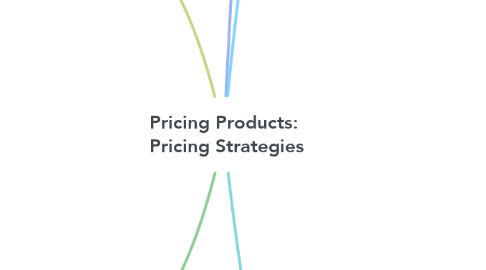
1. New-Product Pricing Strategies
1.1. Pricing Strategies
1.2. Market penetration pricing
1.2.1. low initial price, penetrate the market quickly, attract a large number of buyers
1.2.2. Price sensitive market
1.2.3. Inverse relationship of production and distribution cost
1.3. Market skimming pricing
1.3.1. high initial prices to 'skim' revenue layers
1.3.2. quality, image, support the price
1.3.3. competitors not enter easily
1.3.4. costs producing : small
2. Product Mix Pricing Strategies
2.1. Product line pricing
2.1.1. account the cost diffirence
2.1.2. customer evalue features, competitor's prices
2.2. Optional product pricing
2.2.1. account optional, accessory products, with main product
2.3. Captive product pricing
2.3.1. involve products that must be used along with main product
2.3.1.1. two- part pricing: broken into fixed fee and variable usage fee
2.4. By-product pricing
2.4.1. refers products with little or o value, as result of main product
2.4.2. little or no profit other cost to cover storage and delivery
2.5. Product Bundle pricing
2.5.1. combines several products at a reduced price
3. Price Changes
3.1. Price cuts
3.1.1. reduction in selling price
3.1.1.1. Excess capacuty
3.1.1.2. Increase market share
3.1.2. Buyer Reactions: new models available, models not selling well, quality issdes
3.2. Price increases
3.2.1. increase in selling price
3.2.1.1. Cost inflation
3.2.1.2. Increased demand and lack of supply
3.2.2. Buyer Reactions: Product is hot, company greed
3.3. Solution to responding
3.3.1. reduce price to match competition
3.3.2. maintain price, raise the perceived value through communication
3.3.3. improve quality and increase price
3.3.4. Launch a lower-price ''fighting brand''
4. Public Policy and Pricing
4.1. Price fixing
4.1.1. set prices without talking to competitors
4.2. Predatory pricing
4.2.1. below cost with the intention of punishing a competitor or gaining higher long-term profits by putting the competitor out of business
4.3. Retail( resale) price maintenance
4.3.1. manufactures requires a dealer to charge a specific retail price
4.4. Deceptive pricing
4.4.1. seller states prices or price saving that mislead consumers not actually availble
5. Price Adjustment Strategies
5.1. Discount and allowance pricing
5.1.1. reduces prices to reward customer
5.1.1.1. Discounts
5.1.1.1.1. Cash discount for paying promptly
5.1.1.1.2. Quantity discount when buy big volume
5.1.1.1.3. Functional (trade) discount for selling, storing, distribution, and record keeping
5.1.1.2. Allowances
5.1.1.2.1. Trade-in allowance for turning in an old item when buying a new one
5.1.1.2.2. Promotional allowance to reward dealers for participating in advertising or sales support programs
5.2. Segmented pricing
5.2.1. sells a product at two or more prices even though the difference is not based on cost
5.2.1.1. Customer segment
5.2.1.2. Product form segment
5.2.1.3. Location pricing
5.2.2. Market must be segmentable Segments must show different degrees of demand cannot exceed the extra revenue obtained from the price difference Must be legal
5.3. Psychological pricing
5.3.1. sellers consider the psychology of prices and not simply the economics.
5.4. Promotional pricing
5.4.1. prices are temporarily priced below list price or cost to increase demand
5.4.1.1. Loss leader
5.4.1.1.1. below cost to attract customers,other items at normal markups
5.4.1.2. Special event pricing
5.4.1.2.1. attract customers during certain seasons or periods
5.4.1.3. Cash rebates
5.4.1.3.1. cosumers buy whithin a specified time
5.4.1.4. Low interest financing
5.4.1.4.1. lower the consumer's ''total price''
5.4.1.5. Longer warrantess
5.4.1.5.1. lower the consumer's ''total price'
5.4.1.6. Free maintenance
5.4.1.6.1. lower the consumer's ''total price'
5.5. Geographical pricing
5.5.1. customers in different parts of the country, world
5.5.1.1. FOB
5.5.1.1.1. the title and responsibility passes to the customer
5.5.1.2. Uniformed delivery
5.5.1.2.1. charges the same price plus freight to all customers, all of location
5.5.1.3. Zone pricing
5.5.1.3.1. set up two or more zones where customers within a given zone pay a single totak price
5.5.1.4. Basing point
5.5.1.4.1. choose city as ''basing point'', charges all customers the freight cost associated from that city to the location regardless
5.5.1.5. Freight absorption
5.5.1.5.1. seller absorbs all or part of the actual freight charge, attract business in competitive markets
5.6. Dynamic pricing
5.6.1. prices are adjusted continually to meet characteristics, need of individual, situations
5.7. International pricing
5.7.1. set up prices in a specific country based on country- specific factors
5.7.1.1. Economic, competitive,Laws and regulations, infrastructure, company marketing objectives
